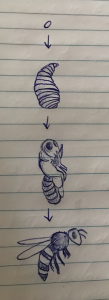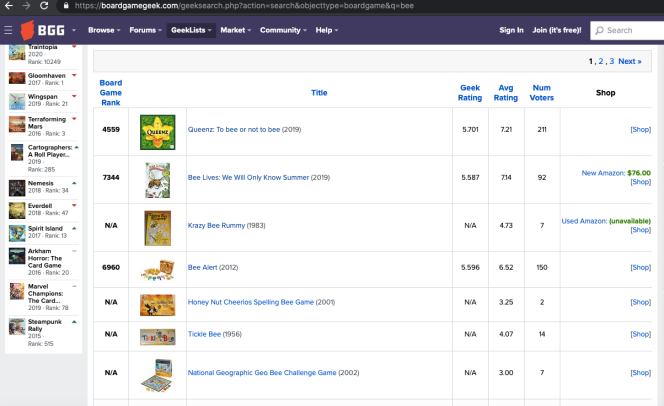It’s one thing to design a game with a team of people, it’s another all together to do it by yourself. Obviously I’m a sucker for punishment and despite the overwhelming amount of work that I’m having to do all on my lonesome, I’m enjoying the process. Something, something… the journey is better than the destination… or whatever.
Game design is problem solving. Something I’m terrible at but enjoy immensely. With more realistic expectations in mind, I’m ready to share where I’m up to with this project. So relax, put on a cup of tea and let’s get into it. I hope you’re ready to talk about bees.
This is the second blog post in a 2-part series detailing my process of designing a board game based on the theme of bees. Here’s a link to the previous post.
Part 1. Research: the entomology of bees
The European Honey Bee and the Bumble Bee really are just two of thousands of species of insects that help pollinate flora across the world. Here in Australia, the Honey Bee is considered an invasive species that has only been present in Australia for the past 190 years – not a long time when it comes to evolution (Invasive bees, 2020).
With global fears on the decimation of honey bee colonies and the impact that could have on our current agricultural systems, scientists are turning towards native insect species for help (Latty, 2019). In Australia we have over 1700 native bee species, nearly all of which are solitary (What are native bees?, 2020). Solitary bees don’t have queens or worker bees, instead in most species, just one female bee mates with a male and builds an individual nest for her eggs, just like a bird.
Bee hotels (yes that’s a thing) are ways the everyday person can help native bees (Bee Hotel Guide, 2020). These homemade bee-friendly hotels are perfect for solitary bees as they provide options for native bees to make nests in your garden. They’re usually comprised of material including old plastic drinking bottles, reeds, pithy stems and timber.
What I like about focussing on Australian native bees, is that they differ in significant ways from the well-known Honey Bee. And although they make up nearly 99% of Australia’s bee population, there is not a lot of readily available media about them. Having a more specific focus is important because…
Part 2. Comparing other bee-centric games
… there are so many different bee games already on the market. A search on Board Game Geek brings up a number of different bee themed games. For those who are feeling more than a little bee obsessed, there’s heaps to choose from that vary from complicated Eurogame styled, resource management games (Bee Lives: We Will Only Know Summer 2019) to more family-friendly, dice-rolling race games (Honey Bee 1995).
This isn’t surprising. With the rise of online crowdsourcing platforms like Kickstarter and the power of word-of-mouth internet advertising, the interest for board games is growing and fuelling a recent boom in the sale of board games (Jolin, 2016).
For me, this means that with so many bee themed games already available, I would need to offer a new take on a tried and tested theme. Most bee games that I’ve found focus on one of two things: bee keeping or the honey bee. Taking a more specialised approach, I get to explore new options and come up with a game that can stand apart from others with similar themes.
Part 3. Mechanics: creating the rules of the game
In the Week 6 BCM300 lecture, game mechanics were defines as the rules and systems in which gameplay is enacted (Moore, C 2020). As I mentioned in last week’s blog post, developing game mechanics that work is no easy task. Changing just one game play element can lead to a whole host of unanticipated reactions. However, it’s important to remember that game mechanics don’t exist in a vacuum. As James Ernest (2011) describes it, “game mechanics are like watch gears”. They are tools that work alongside a strong theme or story and can’t be thought of as seperate entities.

When I first sat down to start trying to piece together rules I ran into a road block. Although I had an idea of what I wanted I felt like there were too many different avenues I could take to build this game. So I spoke to my brother. My brother is a board game fanatic and with the wisdom of someone who’s spent many hours peering over miniature figures and colourful cards, asked one important question.
What do bees do?
It sounds stupid but the process of breaking down a concept and reducing it to the basic components was really helpful. Simplifying and matching the metaphor to the mechanics is something that Matt Forbeck (2011) argues is a necessary step in game development. So I started to simplify.
What are bees? Bees fly, they pollinate, collect nectar and pollen, build nests and they like jazz. I now had something to work with.
Here’s a really rough outline of the rules so far:
- It will be a resource management game similar in concept to Wingspan (2019). Players win by finishing the game (after a number of rounds) with the highest point total. Points are won by collecting cards to complete goals.
- Each player (2-4) will play as a different species of bee.
- Different available actions include:
- Grow a bee (once grown gives you additional actions) from Egg > Larva > Pupa > Adult
- Lay an egg (requires food aka. nectar)
- Go on an expedition. In other words raid the park for resources (draw a card from the Park Deck)
- Pollinate (draw a card from the Pollination Deck)
- Upgrade the nest to create more room for more bees and defend against other players attack.
- Raid another player’s nest. Perhaps this could be simulated through a dice roll and if successful that player may steal a card or resource.
Part 4. Timeline and where do I go from here

Mechanics concept – lifecycle of bees
So as this is a university project – one with a fast approaching deadline – I’m vary conscious of the fact that there is only so much I can do in the time I have. Attempting to be realistic these are my goals for the next couple of weeks:
Develop rudimentary rules: This is something I’ve already started but ideally I want to test a first iteration of my game at least once.
Research the narratology of board games: honestly this is something that really interests me and if I have to pick and choose what I can do in this short amount of time, this is hands down what I’d pick first. If I have time I’d like to start developing the story or narrative of my game and think about ways I can best use my mechanics to tell my story.
Begin playtesting: at least once! I know it will be dreadful but I’d like to start the process of testing and re-testing.
References
Aussiebee.com.au. 2020. Bee Hotel Guide. [online] Available at: <https://www.aussiebee.com.au/bee-hotel-aussie-bee-guide.html> [Accessed 15 May 2020].
Aussiebee.com.au. 2020. What Are Native Bees?. [online] Available at: <https://www.aussiebee.com.au/keyfacts.html> [Accessed 15 May 2020].
Australian Government: Department of Agriculture, Water and the Environment. 2020. Invasive Bees. [online] Available at: <https://www.environment.gov.au/biodiversity/invasive-species/insects-and-other-invertebrates/invasive-bees> [Accessed 15 May 2020].
Boardgamegeek.com. 2020. Boardgamegeek | Gaming Unplugged Since 2000. [online] Available at: <https://boardgamegeek.com/geeksearch.php?action=search&objecttype=boardgame&q=bee> [Accessed 15 May 2020].
Ernest, J 2011, “The Game is not the Rules” in Selinker, M (ed.), The Kobold Guide to BOARD GAME DESIGN, Kirkland: Wolfgang Baur, pp.8-14.
Forbeck, M 2011, “Metaphor vs. Mechanics: Don’t Fight the Fusion” in Selinker, M (ed.), The Kobold Guide to BOARD GAME DESIGN, Kirkland: Wolfgang Baur, pp.29-34.
Jolin, D., 2016. The rise and rise of tabletop gaming. The Guardian, [online] Available at: <https://www.theguardian.com/technology/2016/sep/25/board-games-back-tabletop-gaming-boom-pandemic-flash-point> [Accessed 15 May 2020].
Latty, T., 2019. Native bees are powerful pollinators, and there’s a simple way to help them. ABC News, [online] Available at: <https://www.abc.net.au/news/science/2019-01-29/merits-of-native-bees-can-they-save-us/10749696> [Accessed 15 May 2020].
Moore, C 2020, Seminar 6: Game Mechanics and Rules, lecture video, Game Experience Design BCM300, University of Wollongong, delivered 20 April 2020.
Shoemaker, M 2019, Bee Lives: We Will Only Know Summer, Philadelphia, Hit ‘Em With a Shoe, Board Game.
(Uncredited) 1995, Honey Bee, Jigsaw Toy Factory, Board Game.



[…] via Introducing Drone: a board game about bees — […]
LikeLike
[…] Blog post 2 – Introducing Drone: a board game about Bees […]
LikeLike